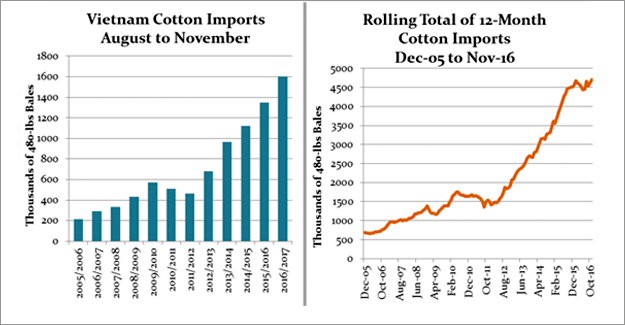Vietnam's Cotton Imports Reflect A Growing Spinning Sector
Vietnam's Cotton Imports Reflect A Growing Spinning Sector

After showing a degree of sluggishness in late 2015-16, Vietnam's cotton imports have turned upward again in the first few months of 2016-17. August through November imports are estimated at about 1.6 million (480-lb) bales, an 18% increase over the same period in 2015-16.
As shown in the graph (See Page 4), the 12-month total (December 2015-Nov 2016) for Vietnam has now met its record level, and is expected to move higher soon. As such, USDA has raised the 2016-17 forecast for Vietnam's imports to 5 million bales.
Rising demand in Vietnam largely stems from demand for Vietnam-produced yarn from China. China customs data show August through October cotton yarn imports from Vietnam up 200,000 bale equivalents from the same point last year.
Vietnam's spinning sector does not appear to have suffered unduly as a result of China's internal cotton prices, which are substantially lower relative to world levels than they have been in recent years. Many analysts expected to see spinning declines in countries that previously benefited from lower Chinese domestic spinning. In particular, India and Pakistan have recently experienced substantial declines in yarn exports to China. However, Vietnam's continuing strong demand is supported by a continuing rise in China's yarn imports from Vietnam.
Global cotton overview
For 2016-17, USDA, in its latest report has raised global production estimates, while use and trade are essentially unchanged, resulting in higher global ending stocks. US production is raised, resulting in higher exports, while US consumption is lowered substantially on increased polyester competition and the pace of mill activity to date, increasing US ending stocks.
2016/17 trade outlook
Major importers
1. Vietnam is boosted 200,000 bales to 5 million on increased yarn demand from China.
2. South Korea is reduced 125,000 bales to 1.15 million on the slow pace of trade to date.
Major exporters
1. Australia is up 200,000 bales to 4.1 million on a much larger forecast crop.
2. United States is raised 200,000 bales to 12.2 million on a larger forecast crop.
3. Burkina is lowered 100,000 bales to 1.15 million on likely uncompetitiveness against other global suppliers.



 textileexcellence
textileexcellence 







